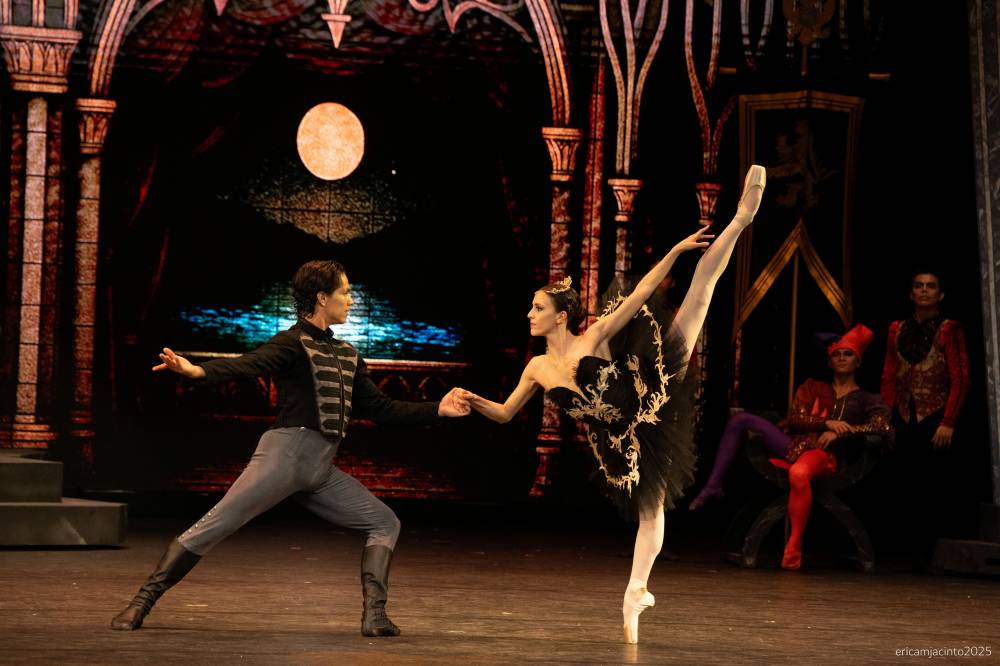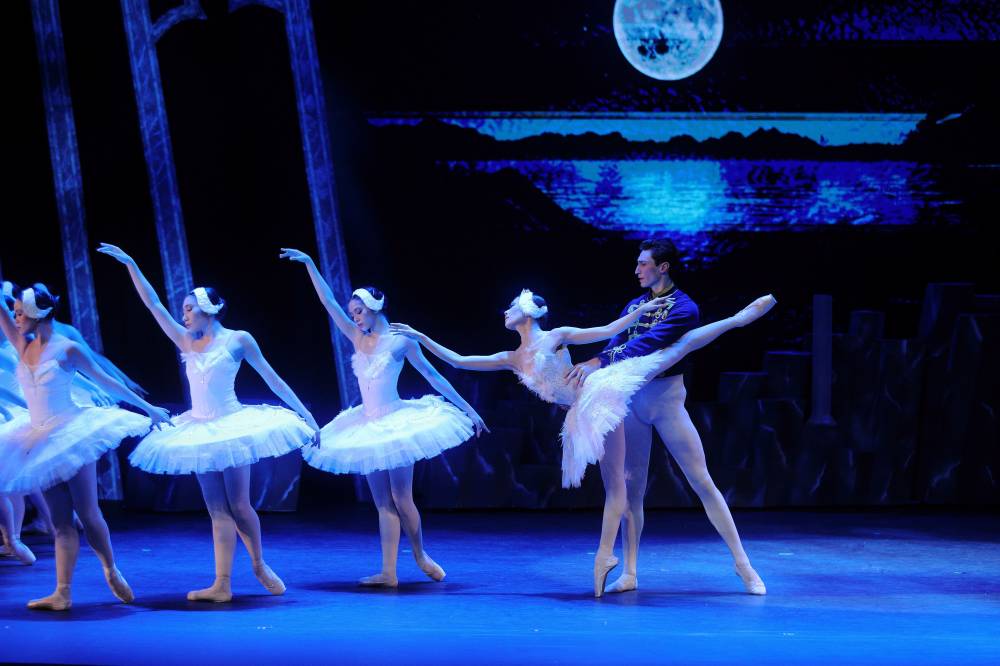Ballet Manila’s homegrown dancers leave audience spellbound

When Ballet Manila (BM) unveiled “Swan Lake” at the Aliw Theater, the house lights fell on more than its imported guest artists. It also brought to the fore the company’s grit and painstaking preparation.
CEO Lisa Macuja-Elizalde believed that the ballet’s greatness did not hinge solely on star turns, but on the dancers’ sweat and discipline. While BM did not enjoy the First World privileges of a live orchestra, a corps of perfectly-proportioned dancers, or an army of coaches and therapists, its homegrown dancers performed with such conviction that audiences were left spellbound.
BM reminded us that determination and unity can transform even the humblest production into something transcendent.
“Swan Lake” tells the story of Prince Siegfried, who falls in love with Odette, a princess cursed to live as a swan by day. Deception unfolds when the sorcerer Rothbart presents his daughter Odile—Odette’s dark double—to trick the prince into a fatal vow. Tchaikovsky’s music builds toward a tragic but redemptive finale where love and sacrifice ultimately break the curse.
Elizalde’s restaging stayed true to the ballet’s Russian roots. Drawing from the Mariinsky tradition, where she once danced, she preserved its most demanding elements: long, physically taxing variations, minimal mime, and choreography that calls for both strength and delicacy.
She also chose to emphasize Russian musicality—marked by elasticity, nuance, and a deep connection to the emotional arc of each phrase—over the more metronomic, precise approach often seen in American versions.
In her reworking of Acts I and III of “Swan Lake,” Elizalde created storylines for supporting characters for clarity. The prince’s tutor has a comic turn as he drinks too much and draws the Queen’s disapproval. The jester, often sidelined, now engages more fully with the prince and his court.
In the Spanish dance in the Act III ball, Odile dances flirtatiously among the men and catches the Prince’s attention. Prince Siegfried, often portrayed as a passive observer, moved among the six princesses, dancing briefly with two. This highlighted his growing confusion in choosing a bride and made Odile’s seduction more believable. The Polish and Hungarian dances were infused with courtly realism, drawing from historical social dance traditions.
Relatable
These changes help make the story more relatable for today’s audiences without losing the ballet’s classicism.
In the gala cast, San Francisco Ballet (SFB) first soloist Katherine Barkman reprised the dual roles she first performed with Ballet Manila in 2017. Barkman, already known for her athletic strength and natural acting, now executed what is traditionally a male feat: multiple pirouettes on one foot traveling from knee to ankle.
She has shed earlier tendencies toward overacting, delivering a more nuanced interpretation of the dual roles. Her movements seemed to breathe with the music, punctuating each accent. Her deep backbends carried shifting emotional weight: as Odette, a slow, controlled arch expressing anguish and longing, reaching out to the prince; as Odile, urgent and intense. Her signature moment in the pas de deux was a sudden, sharp backbend, completed with a wicked, triumphant smile that sealed her deception of the prince.
As Barkman’s Prince, SFB principal Esteban Hernandez was a seamless partner, his refined technique allowing her to shine. His pirouettes were controlled, ending in poised balance rather than flashy display. A seasoned Siegfried, he traced the prince’s arc from youthful hesitation to a resolute choice of heart.
The pas de trois cast of Joshua Enciso, Jessica Pearl Dames, and Shaira Comeros showed maturity via stage presence. But, despite being the company’s current Golden Boy, Enciso’s visible nerves made his movements appear hurried. On the other hand, Dames’ solo was fleet-footed and agile, with a delicate touch, while Comeros moved with elegant, flowing grace.
In the matinee cast, Abigail Oliveiro embodied Odette from the moment she glided onstage. Ethereal as the Swan Queen, she executed deep, arching backbends and sketched expansive, refined lines that evoked vulnerability. In the second act, however, her transformation into Odile, the Black Swan—while subtly seductive—never fully took on a sense of malevolence. Technically, she dispatched the arduous multiple pirouettes and 32 whipping turns with a bit of tension.

Guest artist Nathaniel Remez, a soloist with SFB, stepped onstage with the bearing of a true Prince Siegfried. He knew how to use the breadth and length of his limbs to noble effect, though a hint of nerves showed early on. His partnering was sincere, but in the overhead lifts, he played it too safe, showing the preparation instead of the illusion of effortlessly sweeping his partner off her feet. By the third act, however, he appeared more at ease, his leaps and turns gaining amplitude and confidence.
As the Queen Mother, Elizalde expanded the role. She was not just a symbol of royal authority, but also the poised hostess, overseeing the prince’s ball with her imperious command.
Corps as stars
The pas de trois with Noah Esplana, Nanami Hasegawa, and Jessa Balote felt somewhat restrained, but Esplana lifted the group with his clean execution, buoyant leaps, and genuine enthusiasm.
Known for his striking presence, Mark Sumaylo took on the role of Rothbart, the evil sorcerer. Choreographically, Rothbart’s presence lacked dramatic weight and tension in the triangle between him, the prince, and Odile, thus making the character feel more like a disruptive presence than a serious threat.
Rafael Perez and Benedict Sabularse, alternating as the Jester, danced with energy and precision, earning applause for their whipping, tightly controlled turns with speed and flair, and springy jumps. However, they lacked the playful spark, irreverence, and mischief that should have enlivened the character.
The real stars of the show were the seasoned corps de ballet. The swans moved with striking synchronicity, dancing and breathing as one. The Big Swans’ leaps suspended in mid-air with control, and the swans’ unison jumps—feet sharply pointed—spoke to disciplined refinement. Holding hands throughout, the Little Swans danced with crisp precision and playful charm, never missing a step.
In the Act I waltz, the male corps lifted their partners with coordinated ease, culminating in a group moment as they launched their partners onto their shoulders. This collective precision conjured the magic of “Swan Lake.”
However, the ballroom scene relied mostly on younger company members and scholars, revealing their inexperience. The Polish and Hungarian dances felt too limp, lacking the sharp execution and vibrant energy the choreography demands. The Neapolitan dance, performed by Romeo Peralta and Sayaka Ishibashi, was the cleanest, but its choreography needed to be more challenging to fully showcase their strong technique.
All told, BM’s “Swan Lake” drew its power not from spectacle, but from the precision and the force of its corps de ballet.

















